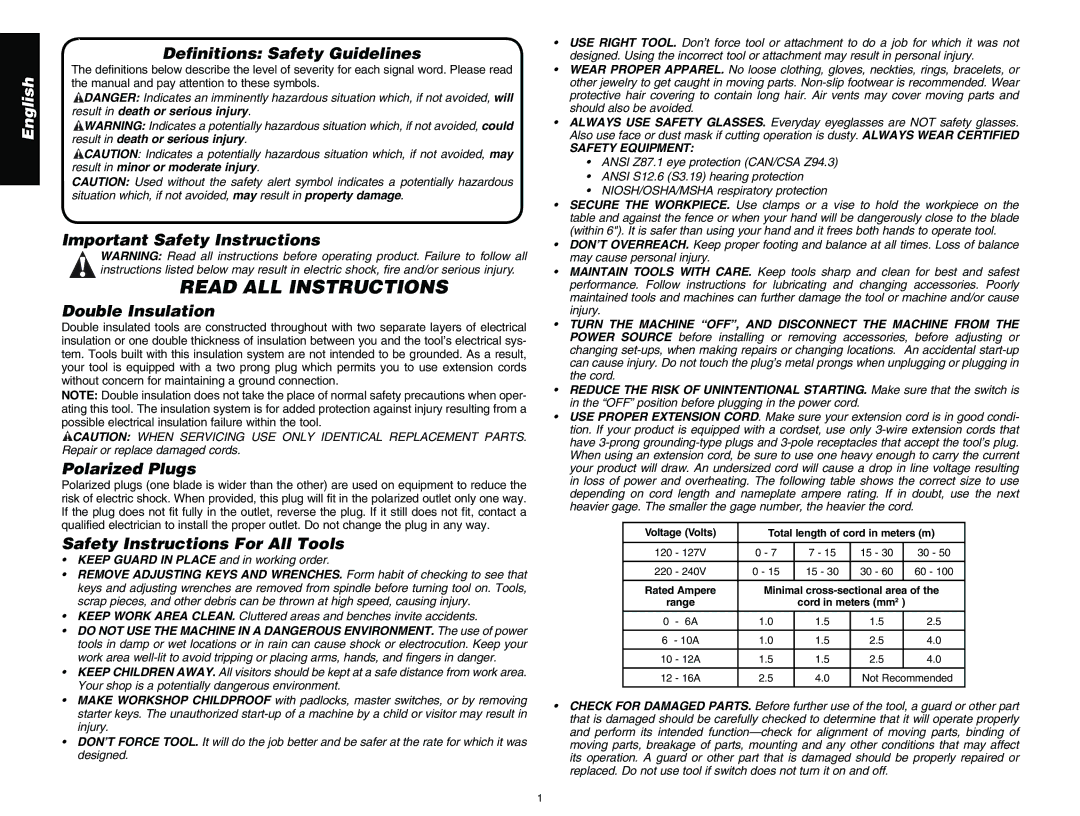
English
Definitions: Safety Guidelines
The definitions below describe the level of severity for each signal word. Please read the manual and pay attention to these symbols.
![]() DANGER: Indicates an imminently hazardous situation which, if not avoided, will result in death or serious injury.
DANGER: Indicates an imminently hazardous situation which, if not avoided, will result in death or serious injury.
![]() WARNING: Indicates a potentially hazardous situation which, if not avoided, could result in death or serious injury.
WARNING: Indicates a potentially hazardous situation which, if not avoided, could result in death or serious injury.
![]() CAUTION: Indicates a potentially hazardous situation which, if not avoided, may result in minor or moderate injury.
CAUTION: Indicates a potentially hazardous situation which, if not avoided, may result in minor or moderate injury.
CAUTION: Used without the safety alert symbol indicates a potentially hazardous situation which, if not avoided, may result in property damage.
Important Safety Instructions
WARNING: Read all instructions before operating product. Failure to follow all instructions listed below may result in electric shock, fire and/or serious injury.
READ ALL INSTRUCTIONS
Double Insulation
Double insulated tools are constructed throughout with two separate layers of electrical insulation or one double thickness of insulation between you and the tool’s electrical sys- tem. Tools built with this insulation system are not intended to be grounded. As a result, your tool is equipped with a two prong plug which permits you to use extension cords without concern for maintaining a ground connection.
NOTE: Double insulation does not take the place of normal safety precautions when oper- ating this tool. The insulation system is for added protection against injury resulting from a possible electrical insulation failure within the tool.
![]() CAUTION: WHEN SERVICING USE ONLY IDENTICAL REPLACEMENT PARTS. Repair or replace damaged cords.
CAUTION: WHEN SERVICING USE ONLY IDENTICAL REPLACEMENT PARTS. Repair or replace damaged cords.
Polarized Plugs
Polarized plugs (one blade is wider than the other) are used on equipment to reduce the risk of electric shock. When provided, this plug will fit in the polarized outlet only one way. If the plug does not fit fully in the outlet, reverse the plug. If it still does not fit, contact a qualified electrician to install the proper outlet. Do not change the plug in any way.
Safety Instructions For All Tools
•KEEP GUARD IN PLACE and in working order.
•REMOVE ADJUSTING KEYS AND WRENCHES. Form habit of checking to see that keys and adjusting wrenches are removed from spindle before turning tool on. Tools, scrap pieces, and other debris can be thrown at high speed, causing injury.
•KEEP WORK AREA CLEAN. Cluttered areas and benches invite accidents.
•DO NOT USE THE MACHINE IN A DANGEROUS ENVIRONMENT. The use of power tools in damp or wet locations or in rain can cause shock or electrocution. Keep your work area
•KEEP CHILDREN AWAY. All visitors should be kept at a safe distance from work area. Your shop is a potentially dangerous environment.
•MAKE WORKSHOP CHILDPROOF with padlocks, master switches, or by removing starter keys. The unauthorized
•DON’T FORCE TOOL. It will do the job better and be safer at the rate for which it was designed.
•USE RIGHT TOOL. Don’t force tool or attachment to do a job for which it was not designed. Using the incorrect tool or attachment may result in personal injury.
•WEAR PROPER APPAREL. No loose clothing, gloves, neckties, rings, bracelets, or other jewelry to get caught in moving parts.
•ALWAYS USE SAFETY GLASSES. Everyday eyeglasses are NOT safety glasses. Also use face or dust mask if cutting operation is dusty. ALWAYS WEAR CERTIFIED
SAFETY EQUIPMENT:
•ANSI Z87.1 eye protection (CAN/CSA Z94.3)
•ANSI S12.6 (S3.19) hearing protection
•NIOSH/OSHA/MSHA respiratory protection
•SECURE THE WORKPIECE. Use clamps or a vise to hold the workpiece on the table and against the fence or when your hand will be dangerously close to the blade (within 6"). It is safer than using your hand and it frees both hands to operate tool.
•DON’T OVERREACH. Keep proper footing and balance at all times. Loss of balance may cause personal injury.
•MAINTAIN TOOLS WITH CARE. Keep tools sharp and clean for best and safest performance. Follow instructions for lubricating and changing accessories. Poorly maintained tools and machines can further damage the tool or machine and/or cause injury.
•TURN THE MACHINE “OFF”, AND DISCONNECT THE MACHINE FROM THE POWER SOURCE before installing or removing accessories, before adjusting or changing
•REDUCE THE RISK OF UNINTENTIONAL STARTING. Make sure that the switch is in the “OFF” position before plugging in the power cord.
•USE PROPER EXTENSION CORD. Make sure your extension cord is in good condi- tion. If your product is equipped with a cordset, use only
Voltage (Volts) | Total length of cord in meters (m) | |||||
|
|
|
|
|
|
|
120 | - 127V | 0 - 7 | 7 - 15 | 15 - 30 |
| 30 - 50 |
|
|
|
|
|
|
|
220 | - 240V | 0 - 15 | 15 - 30 | 30 - 60 |
| 60 - 100 |
|
|
|
|
| ||
Rated Ampere | Minimal | |||||
range |
| cord in meters (mm2 ) |
| |||
0 | - 6A | 1.0 | 1.5 | 1.5 |
| 2.5 |
|
|
|
|
|
|
|
6 | - 10A | 1.0 | 1.5 | 2.5 |
| 4.0 |
|
|
|
|
|
|
|
10 | - 12A | 1.5 | 1.5 | 2.5 |
| 4.0 |
|
|
|
|
|
| |
12 | - 16A | 2.5 | 4.0 | Not Recommended | ||
|
|
|
|
|
|
|
•CHECK FOR DAMAGED PARTS. Before further use of the tool, a guard or other part that is damaged should be carefully checked to determine that it will operate properly and perform its intended
1
